The Mapping Strategic Moves Method (v1, 2024)
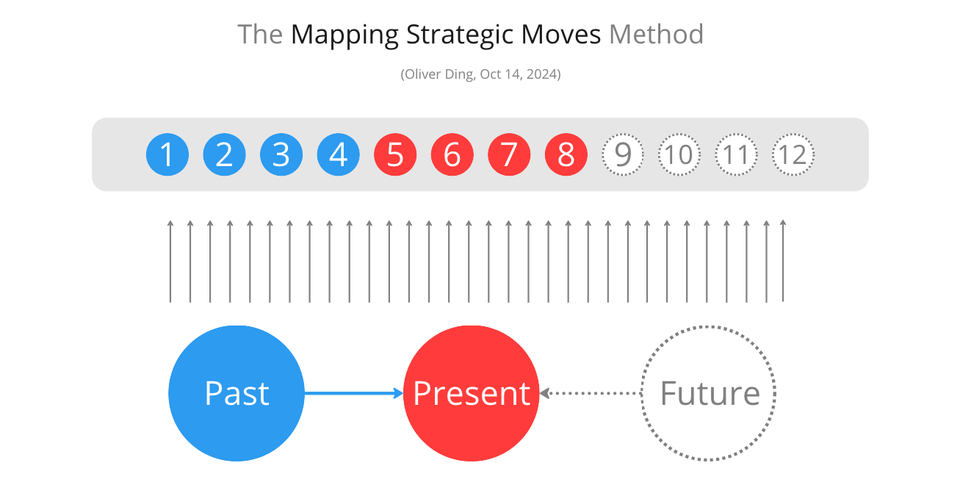
Strategy, Narrative, and Project Engagement
by Oliver Ding
This article, originally written on October 15, 2024, was featured in my 2024 book draft, Strategic Moves: Mapping Knowledge Engagement and Structural Choice.
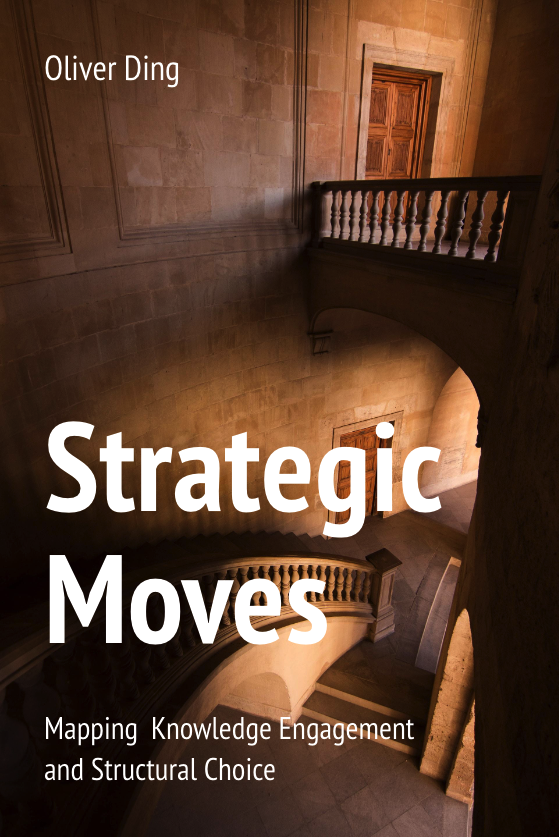
In September 2024, I utilized the House of Project Engagement and other thematic maps as narrative tools to create the Mapping Strategic Moves method. This approach helps knowledge creators craft forward-thinking life strategies by reflecting on their past and connecting it to future possibilities.
This article outlines the process of the Mapping Strategic Moves method and introduces 12 associated themes.

These themes are organized into three key groups:
The “Past” Group:
- 1 — Modeling a Strategic Journey
- 2 — Modeling an Actual Project
- 3 — Reflecting on Structural Choices
- 4 — Refreshing a Creative Identity
The “Present” Group:
- 5 — Finding Relevant Meaning
- 6 — Exploring Emerging Themes
- 7 — Capturing Narrative Frames
- 8 — Enhancing Strategic Mindsets
The “Future” Group:
- 9 — Framing a Concept System
- 10 — Proposing a Value Circle
- 11 — Designing a Possible Project
- 12 — Making a Predictive Model
Each group corresponds to a specific “Mode” of the method.
Each theme is described in terms of both an entity and an operation. For example, “Exploring Emerging Themes” refers to the entity “Emerging Themes” and the operation “Exploring.”
Some themes require a sequence of operations. For instance, “Selecting a Strategic Theme” logically follows “Exploring Emerging Themes.” However, to maintain simplicity, I focus on one primary operation for each theme.
1. The Time Structure of “Strategy”
In the previous article titled Mapping Strategic Moves #16: The Strategic Life Development Toolkit, I introduced the time structure of “Strategy”:
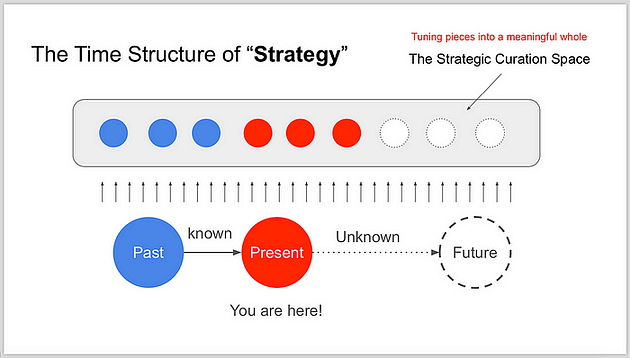
The above slide is inspired by the Path of Creative Life and the fleeting moment. See the diagram below.
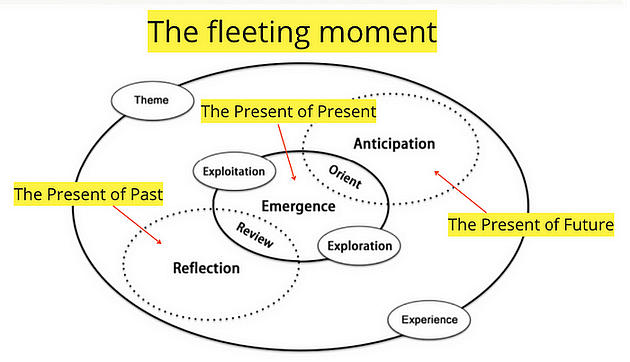
Inspired by Activity Theory, Creative Life is viewed as the transformation between individual actions and collective culture. From a phenomenological perspective, the above diagram echoes a classical view of time, developed by Saint Augustine (354–430).
This diagram draws inspiration from theoretical sociologist Ping Keung Lui’s 2002 book Gaze, Action, and the Social World. Lui’s approach begins with an ontology of action, influenced by Saint Augustine (354–430), Martin Heidegger (1889–1976), and Maurice Merleau-Ponty (1908–1961). Lui expresses this concept through the statement :
The body is in action, action is in the fleeting moment, the fleeting moment is in the body.
According to Lui, “This moment is Augustinian, it comprises at the same time the Present of the Past, the Present of the Present, and the Present of the Future. The actor Remembers in the present of the past, Pays Attention in the present of the present, Expects in the present of the future.” (p.235–236, 2010, The Scientific Project of Sociology)
More details can be found in Mapping Strategic Moves #6: Before, Role Models, and After.
Building on the time structure of “Strategy”, the slide sets a new thematic space to curate “Past,” “Present,” and “Future” into a meaningful whole, including known and unknown.
I name this thematic space Strategic Curation Space.
This is the foundation of the Mapping Strategic Moves method.
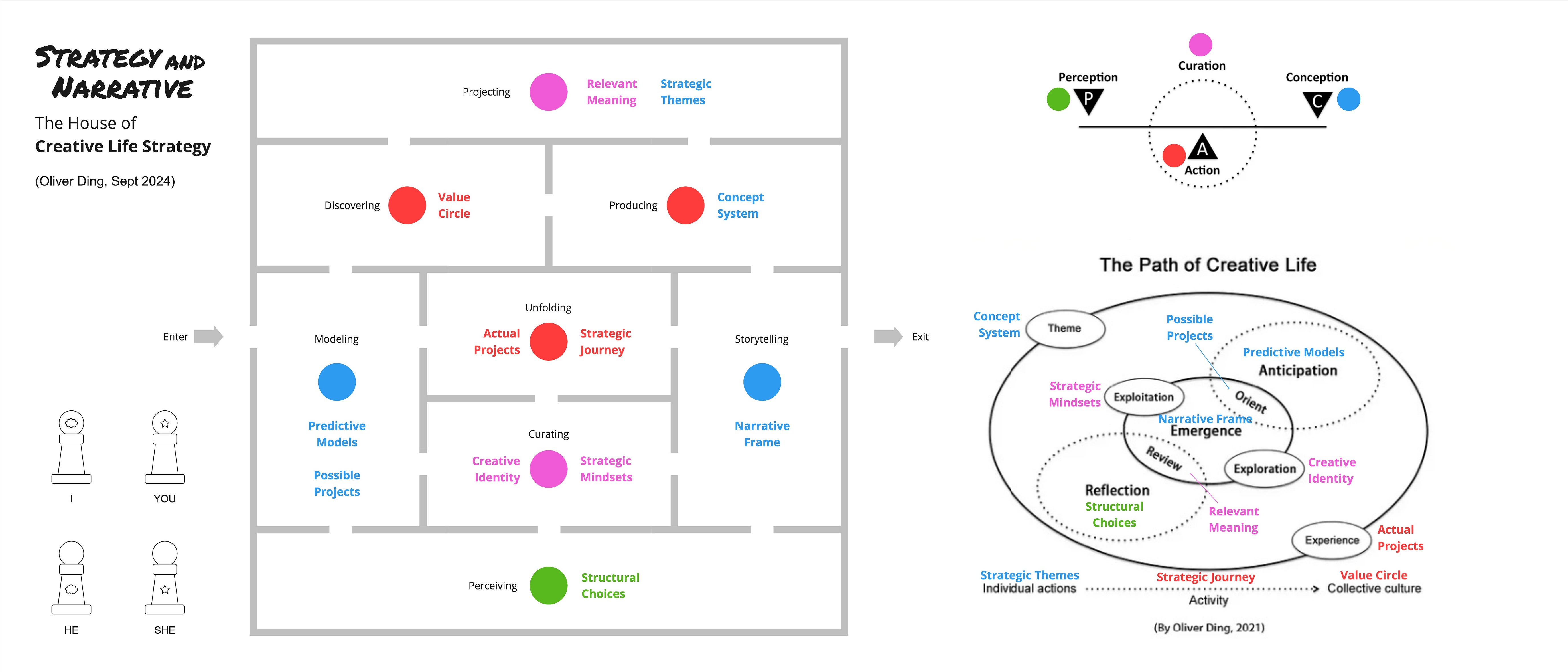
The above diagram also placed the related 12 entities in Strategy and Narrative: the House of Creative Life Strategy and the Path of Creative Life model.
2. The “Map — Move — Model — Method” Structure
I used a special structure to develop the method:
- Map
- Move
- Model
- Method
For each case, I select an existing map or design a new one to represent the social landscape or situational contexts relevant to the case. Inspired by the House of Project Engagement, I designed a series of “Houses” as thematic maps:
- Social Landscape: The House of Project Engagement
- Strategy and Narrative: The House of Creative Life Strategy
- Castle and Forest: The House of Knowledge Discovery
- Thematic Matrix: The House of Thematic Genidentity
- Container and Containee: The House of Ecological Practice
I distinguish between maps and models: Maps represent the social landscape and situational contexts, and Models represent predictive models made by actors. In some cases, actors use specific knowledge frameworks as their predictive models to guide their projects.
Moves metaphorically describe real actions taken by actors within these contexts.
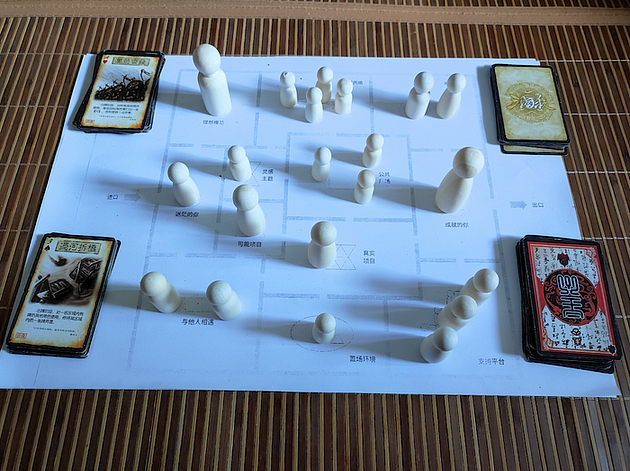
For example, the House of Project Engagement serves as a Map for mapping strategic moves. It operates independently of Models.
However, the Mapping Strategic Moves method goes beyond using the House of Project Engagement and other thematic maps to narrate events. To dive deeper into the complexity of the Moves, various knowledge frameworks are adopted as Models.
The related models are curated as the Strategic Life Development Toolkit.
3. The Present of Past and Reflection
The Mapping Strategic Moves method is designed to help knowledge creators develop a forward-thinking life strategy by reflecting on their past while connecting it to future possibilities. To guide this process, I introduce three groups of themes for reference.
The “Past” group focuses on Reflection.
- 1 — Modeling a Strategic Journey
- 2 — Modeling an Actual Project
- 3 — Reflecting on Structural Choices
- 4 — Refreshing a Creative Identity
3.1 Modeling a Strategic Journey
The first theme, Modeling a Strategic Journey, involves using a thematic map to visually represent the key moves in a strategic journey. For instance, I used the House of Project Engagement as a thematic map to explore four case studies from my creative journey between 2019 and 2024.
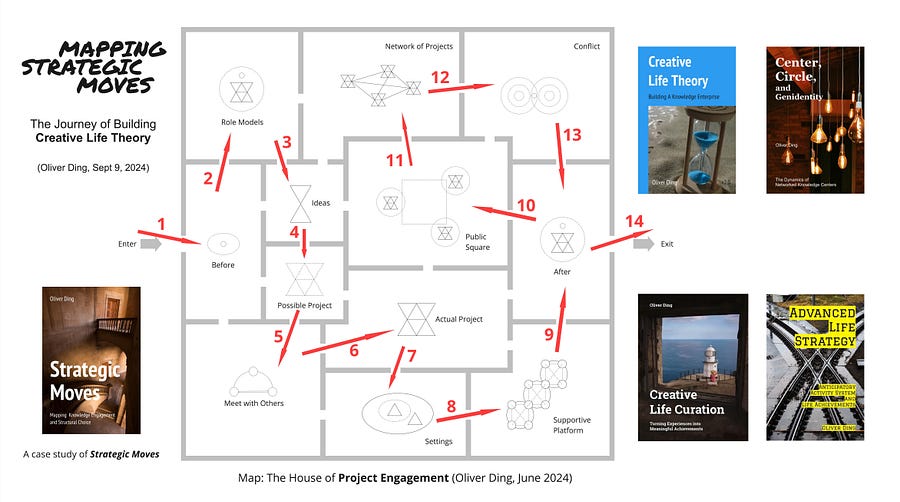
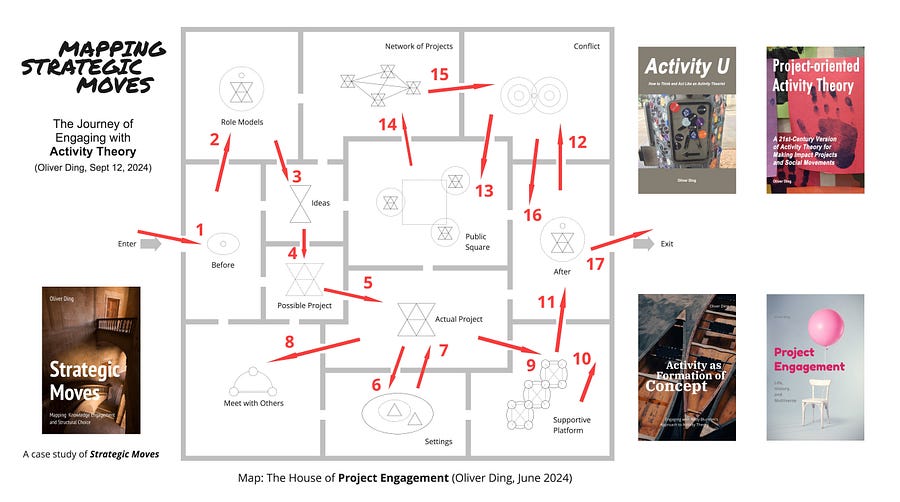
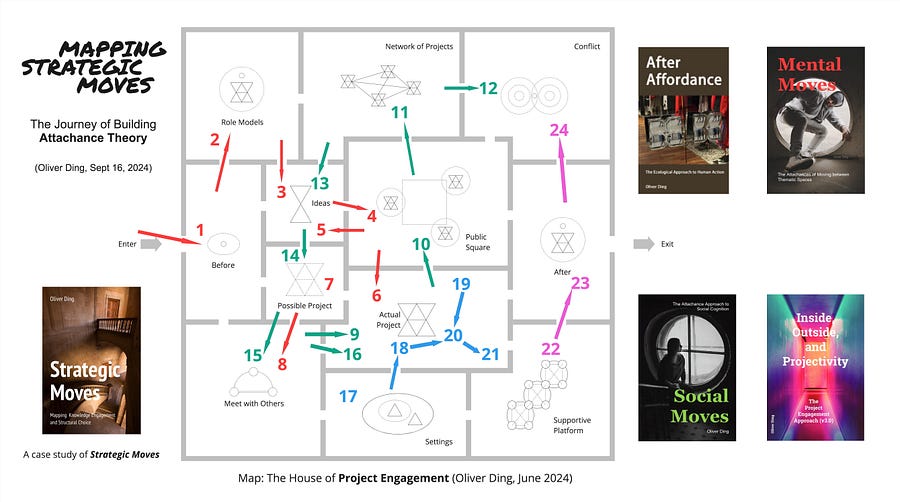
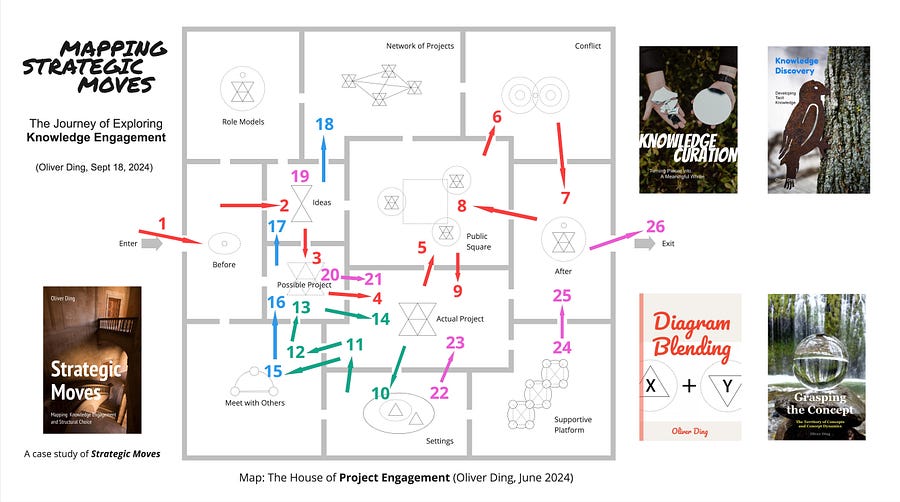
The House of Project Engagement showcases different social landscapes and was designed to support life narrative practices. While it can be used within the Mapping Strategic Moves method, its primary function is general.
Some similar yet more specific maps are needed for this method.
For example, how does one develop a knowledge element, such as transforming a theme into a theoretical concept?
This idea inspired me to combine the Knowledge Discovery Canvas and the Grasping the Concept Model to design a new thematic map: Castle and Forest: The House of Knowledge Discovery.

While thematic maps visually represent strategic moves, the method also employs the Strategic Changes Model to strategically interpret the creative journey.
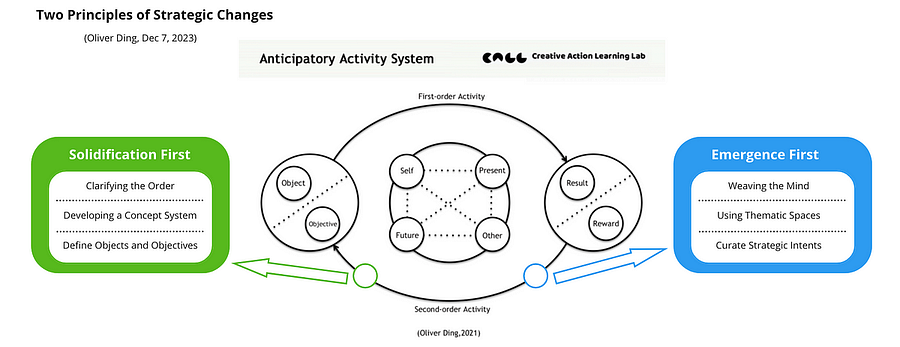
More details about the Strategic Changes model can be found in Mapping Strategic Moves #5: Ideas, Possible Project, and Actual Project.
3.2 Modeling an Actual Project
The second theme, Modeling an Actual Project, involves reflecting on a particular completed project from the past.
The Actual Project is the Central Activity of a Strategic Journey. Unlike the Possible Project, which refers to early-stage, canceled, unfinished, or failed projects, the Actual Project is a term reserved for long-term, finished, and successful endeavors. It represents the full realization of an idea into a completed objective.
There are several ways to model an actual project. One approach is to use the Mediating Action Model, which forms the foundation of Activity Theory.

More details can be found in Mapping Thematic Journey (Engaging with Activity Theory, 2020–2022).
Another useful tool is the Developmental Project Model, a core component of the Project Engagement approach.

More details can be found in the Developmental Project Model.
3.3 Reflecting on Structural Choices
The third theme, Reflecting on Structural Choices, involves identifying patterns of moves between different categories of social or cognitive landscapes. Thematic maps use thematic rooms to represent these categories.
After presenting moves on thematic maps, we can see patterns of our moves. One common example of such a pattern is the “GAP” project.
A “GAP” project refers to informal activities between formal projects. These are categorized using the “After | Before” structure:
- The “After” Project, like Creative Life Curation
- The “Before” Project, like Creative Life Discovery
The timing of a “GAP” project is a Structural Choice, either between creative projects or life journeys.
For instance, a significant creative transition occurred in October 2022 between two formal projects within my journey:
- Before: The Knowledge Curation Project (June 26, 2020 — Oct 18, 2022)
- After: The Creative Life Theory (v1) Project (Nov 2, 2022 — Dec 29, 2022)

Choosing whether to initiate a “GAP” project after closing a major creative endeavor or life journey is a structural choice. For many, this is often a hidden or unconscious decision.
More details can be found in A 5-year Creative Journey and Two “GAP” Projects.
3.4 Refreshing a Creative Identity
Refreshing a Creative Identity (#4) focuses on the process of thematic identity curation.
“Theme” and “Identity” are two key elements of the Developmental Project Model, which forms the foundation of the Project Engagement approach. Between 2021 and 2024, I developed several knowledge frameworks that explore themes, identity, and related concepts.
The Mapping Strategic Moves method leverages the Thematic Identity Curation Toolkit to observe and guide the evolution of creative identity.

The Thematic Identity Curation framework outlines the following key stages:
- Thematic Echo
- Thematic Blend
- Thematic Integration
- Creative Projects
- Identity Development
Each stage is paired with a relevant knowledge framework, forming a comprehensive toolkit.
More details can be found in Mapping Strategic Moves #6: Before, Role Models, and After.
4. The Present of Present and Attention
The Present of Present is about paying attention to the current situation and identifying both challenges and opportunities.
During the testing of the Mapping Strategic Moves method, I identified the following themes within the “Present” group:
- #5 — Finding Relevant Meaning
- #6 — Exploring Emerging Themes
- #7 — Capturing Narrative Frames
- #8 — Enhancing Strategic Mindsets
4.1 Finding Relevant Meaning
Finding Relevant Meaning (#5) revolves around understanding the relevance of the “Self — Other” relationship in various contexts.
This method selects three thematic rooms to represent a path:
- The “Public Square” Thematic Room
- The “Meet with Others” Thematic Room
- The “Settings” Thematic Room

The process begins with meeting strangers in public spaces, followed by building trust through ongoing communication and meaningful interactions. Finally, collaborative projects take shape within the defined settings that frame and guide them.
To deepen the understanding of interpersonal interactions and collaborative project engagement, I developed the ARCH framework — a visual language designed to curate relevant knowledge frameworks. It has now become a key component of the Project Engagement approach (v3.1).
More details can be found in Mapping Strategic Moves #7: Public Square, Meet with Others, and Settings.
4.2 Exploring Emerging Themes
Exploring Emerging Themes (#6) involves capturing new ideas from the present, particularly after mapping the strategic moves.
For instance, while writing previous articles, I identified three new themes:
- The “See the Move” theme
- The “Thematic Space Theory” theme
- The “Strategic Life” theme

On October 4, 2024, I used three thematic maps to curate some ideas from the Ecological Practice approach, the Project Engagement approach, and Curativity Theory. The outcome is the Strategic Life Development framework. Later, I recognized that I should use the “Strategic Life” theme to highlight the “Strategy” aspect of human life. This theme differs from the “Strategic Moves” theme, which focuses on developing Ecological Strategic Cognition.
On October 7, 2024, I designed a visual representation for the “See the Move” theme, which I later used as the title for a trilogy about Attachance Theory: Mental Moves, Social Moves, and Strategic Moves. A related post can be found on LinkedIn.
While developing Attachance Theory, the Thematic Space Theory emerged as a by-product. This inspired me to conduct a case study on the development of Thematic Space Theory. See Mapping Strategic Moves #13: The Journey of Building Thematic Space Theory.
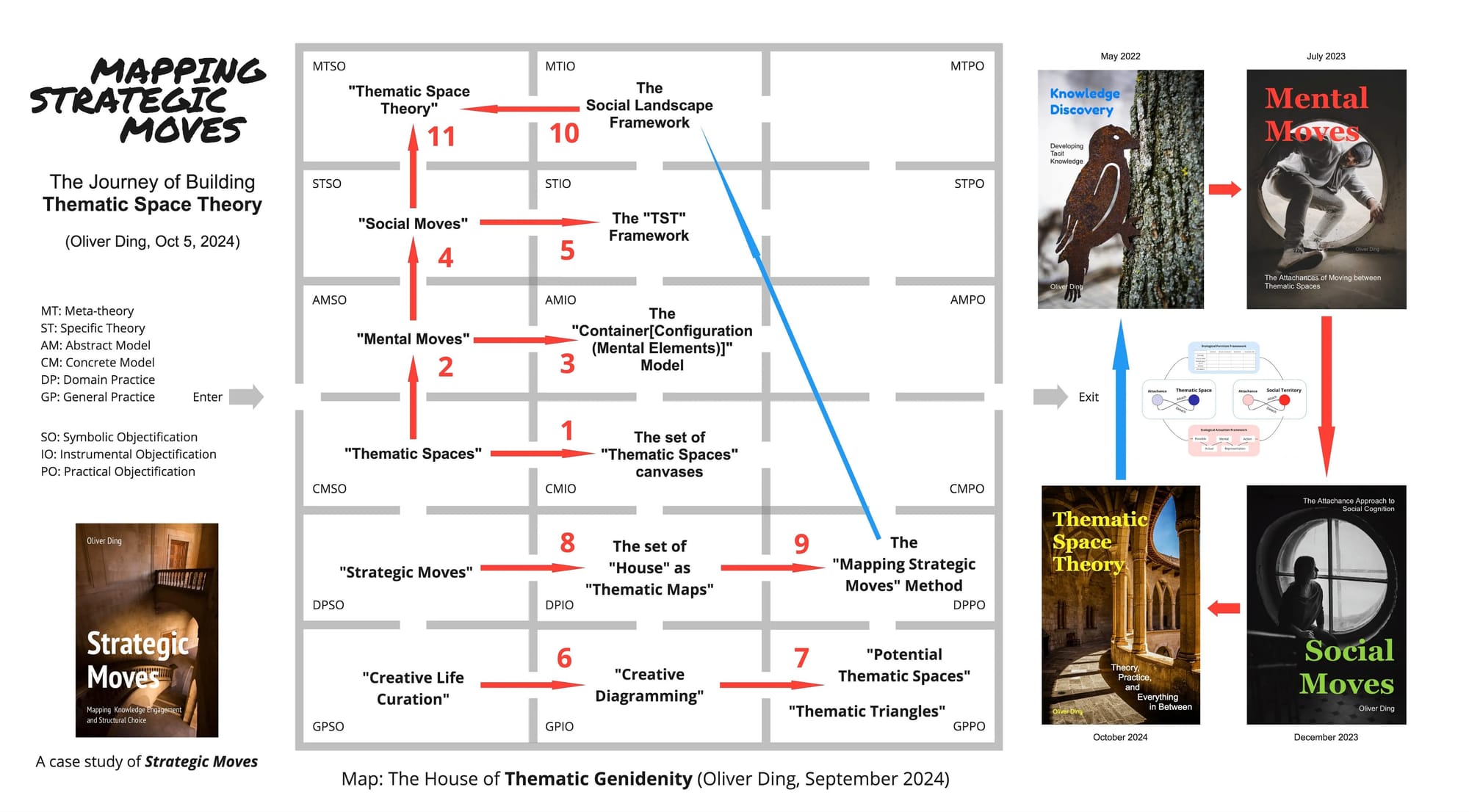
Emerging themes are powerful mediators that can lead to new strategic themes or new strategic curations. For example, the “Strategic Life” theme prompted me to revisit the Applied Activity Theory project.
The Applied Activity Theory project defines eight aspects of human life. See the diagram below. More details can be found in Introducing Applied Activity Theory: A New Tool for Selecting Frameworks.
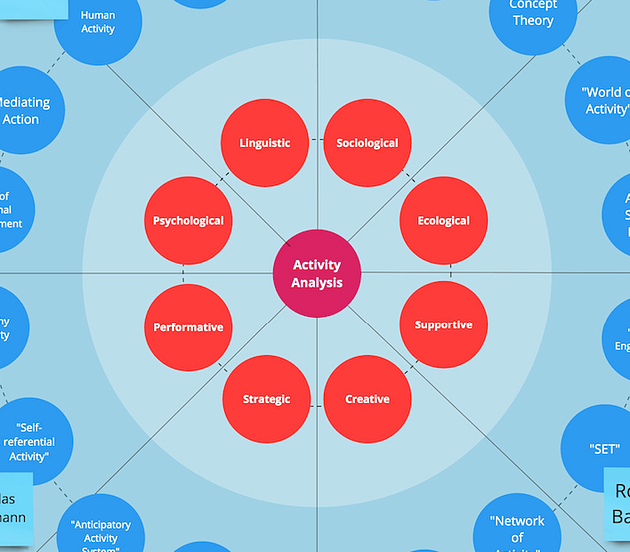
In 2023, I drafted a book titled Creative Life Theory. By 2024, the “Strategic Life” theme may evolve into Strategic Life Theory. Together, these themes suggest a new path toward developing a comprehensive theory of human life: addressing one aspect at a time.
4.3 Capturing Narrative Frames
Capturing Narrative Frames (#7) refers to the technique of uncovering the hidden frames within storytelling and narratives.
An example can be found in Mapping Strategic Moves #5: Ideas, Possible Project, and Actual Project.

A4
I designed Knowledge Discovery Canvas to initiate this project as Phase I of Slow Cognition. While it produced a new tool for mapping knowledge discovery, it didn’t achieve the original goal of the project.
C7
In January 2022, I initiated the Slow Cognition Project (Phase I), which involved developing the Thematic Space Canvas. The concept of Thematic Space later became crucial to the further development of Attachance Theory.
Note that A4 and C7 refer to the same Possible Project but are interpreted differently in two case studies. This illustrates the concept of Narrative Frame within the Mapping Strategic Moves method.
The Narrative Frame acts as a hidden layer between Story and Action. By choosing distinct perspectives and adjusting the narrative order, the same Possible Project can be reframed into multiple stories, each with unique meanings.
4.4 Enhancing Strategic Agency
Enhancing Strategic Agency (#8) is about cultivating mental capacities to navigate the strategic journey effectively.
After reviewing the Creative Life Strategy diagram, I identified eight themes, each corresponding to one of four entities within the Curativity of Action.
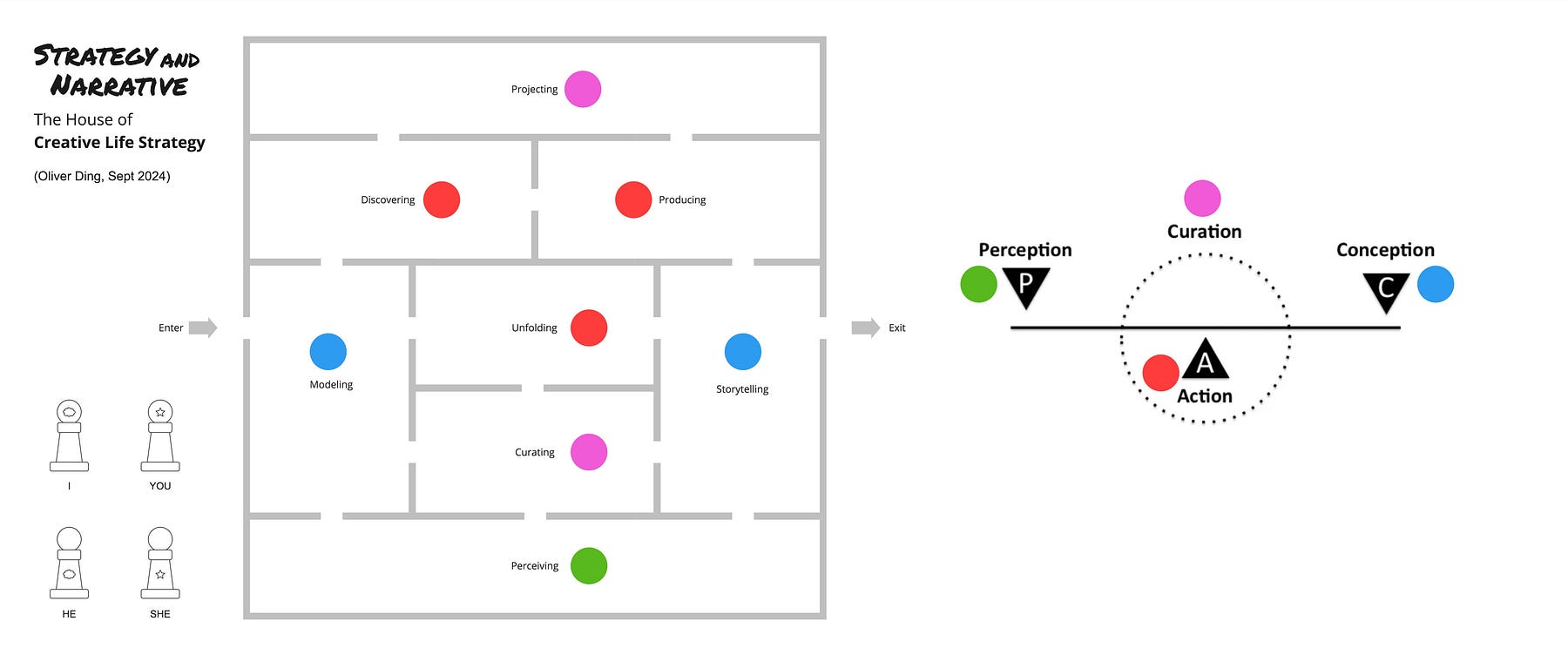
Action:
- Discovering
- Producing
- Unfolding
Perception:
- Perceiving
Conception:
- Modeling
- Storytelling
Curation:
- Projecting
- Curating
To master these themes, creators need to develop eight corresponding mental capacities, which I refer to as strategic agency.
More more information, see Mapping Strategic Moves #10: The Strategic Curation Model, Near History, and Possible Selves.
5. The Present of Future and Anticipation
The Present of Future focuses on the theme of Anticipation, and incorporates possible selves, imagined journeys, and predictive models.
The following themes are featured in the “Future” Group:
- #9 — Framing a Concept System
- #10 — Proposing a Value Circle
- #11 — Designing a Possible Project
- #12 — Making a Predictive Model
5.1 Framing a Concept System
After capturing new ideas in Exploring Emerging Themes (#6), the next task is Framing a Concept System (#9).
Emerging themes often evolve into a new strategic theme, which in turn leads to a network of interconnected themes and, ultimately, a new concept system.
For instance, the theme of Social Landscape originated from my work on the House of Project Engagement. As I designed, narrated, and tested the framework, the theme of Social Landscape gradually emerged
Later, I detached the theme of Social Landscape from the original context and developed it into an independent framework.

More details can be found in Mapping Strategic Moves #11: The House of Knowledge Discovery and the Social Landscape Framework.
5.2 Proposing a Value Circle
Proposing a Value Circle (#10) refers to a technique for navigating the macro-social context, such as networks, platforms, and systems, and associated issues such as conflict, support, reward, and exchange.
The process begins with a single project, expands into a network of projects, and eventually connects to the broader social structures in which these projects are embedded.
While the macro-social context is difficult for any individual to change, an actor can develop their own Value Circle as a strategic niche to support personal and professional growth.
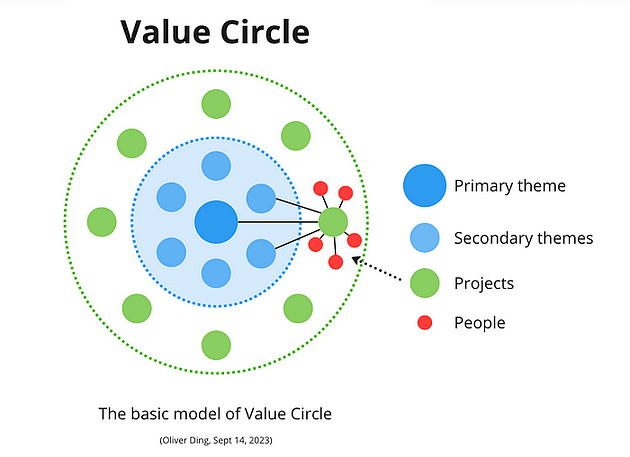
In the “Present” mode, Finding Relevant Meaning (#5) is about understanding the present relevance of the “Self — Other” relationship in various contexts. In the “Future” mode, Proposing a Value Circle (#10) follows Finding Relevant Meaning (#5), as understanding the “Self — Other” relationship is key to designing a Value Circle.
In the “Present” mode, we capture new ideas at #6 (Exploring Emerging Themes), then select a strategic theme that leads to #9 (Framing a Concept System) in the “Future” mode.
Similarly, in the “Present” mode, Exploring Emerging Themes (#6) leads to the selection of a strategic theme, which transitions to Framing a Concept System (#9) in the “Future” mode.
Proposing a Value Circle (#10) also follows Framing a Concept System (#9) as a Value Circle comprises three layers: a network of themes, a network of projects, and a network of people.
More details can be found in Mapping Strategic Moves #8: Network of Projects, Supportive Platform, and Conflict.
The diagram below illustrates a case study of collaboration among three knowledge centers.
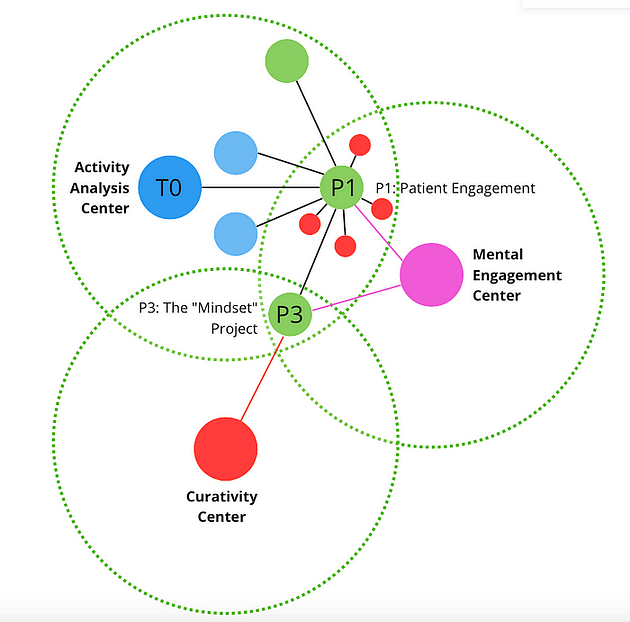
The above diagram represents a minimal-Value Circle, which includes:
- Two People
- Three Knowledge Centers
- Two Projects
From September 2023 to December 2023, the main collaboration occurred between the Curativity Center and the Mental Engagement Center. This collaboration focused on thematic conversations aimed at developing a new theoretical framework of Mindset.

The outcomes of the Mindset project helped shape the Mental Engagement Center, leading to the creation of new knowledge themes and frameworks.
More details can be found in Value Circle #5: Building A Joint Knowledge Center.
5.3 Designing a Possible Project
Designing a Possible Project (#11) serves as a bridge between “Ideas” and “Actual Project.” It captures an individual’s anticipations, plans, explorations, experiments, and tentative actions.
When paired with the Key Term “Actual Project” in mapping strategic moves, early-stage, canceled, unfinished, or failed projects can be placed in the “Possible Project” thematic room.
The value of the “Possible Project” lies in tracing the progression from ideas to objectives, from objectives to objects, and from objects to outcomes — including both planned products and unexpected by-products.
On October 8, 2024, I published In Mapping Strategic Moves #12: The House of Thematic Genidentity and the Concept Development Framework, where I outlined a draft of the Concept Development Framework in section 3.
3. The Concept Development Framework
3.1 The “Theme(Concept)” Ontology
3.2 The “THEORY (PRACTICE)” Realism
3.3 The “Model (Map)” Hermeneutics
3.4 Actors: The Strategic Thematic Exploration Framework
3.5 Professionals: The Evolving Concept System
3.6 Empirical Researchers: The Concept Dynamics Framework
3.7 Theoretical Researchers: The Multiple Perspectives Framework
This outline itself can be considered a Possible Project. From here, I could initiate an Actual Project by writing or editing a book based on this framework or taking a different route.
Later, I incorporated it into the Thematic Space Theory project on October 10, 2024. See the following section for more details.
To better understand the “Ideas — Possible Project — Actual Project” path, refer to Mapping Strategic Moves #5: Ideas, Possible Project, and Actual Project.
5.4 Making a Predictive Model
Making a Predictive Model (#12) is closely connected to Designing a Possible Project (#11).
For the Strategic Life Development project, I distinguished between a General Predictive Model and Particular Predictive Models
The General Predictive Model refers to a person’s mind and knowledge. For a specific project, however, an individual will create a Particular Predictive Model to guide the project’s development. In essence, they use this model to forecast the project’s future.
A predictive model can be explicit, such as a diagram or a document, or it can be implicit, residing in the person’s mind without external visualization.
From my empirical research, I’ve observed that many people prefer visualizing or documenting their predictive models because it helps clarify their thoughts. However, they often keep these models private unless the project demands a public version for storytelling or strategic purposes.
The Predictive Model emerges through a process of “objective–subjective” knowledge curation. For example, a friend of mine used psychological concepts and the OKR method to create a predictive model for her life development program. She refined the model over time to better accommodate changes in her clients’ needs.
I developed the Strategic Curation Model as a tool for creating predictive models.
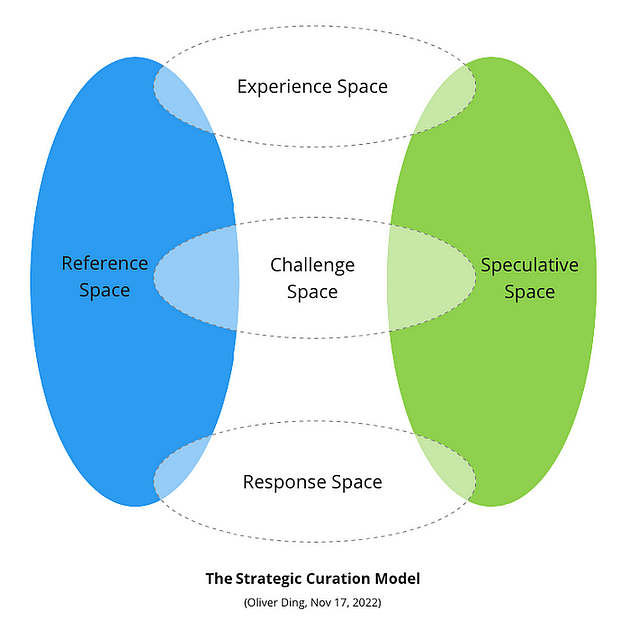
More details can be found in Mapping Strategic Moves #10: The Strategic Curation Model, Near History, and Possible Selves.
Several days ago, I made a predictive model for an upcoming project: curating a new book titled Thematic Space Theory: Theory, Practice, and Everything in Between.

This upcoming book envisions Thematic Space Theory as an ecological approach to social cognition, with a specific focus on knowledge engagement. While Social Moves established an ecological perspective on social cognition in general, Thematic Space Theory will concentrate on how we engage with knowledge.
The idea for this possible project emerged from mapping the journey of developing Thematic Space Theory.

#10B/11B — “Thematic Space Theory”
Over the past several days, I’ve used the House of Thematic Genidentity to reflect on the evolution of Thematic Spaces. This led me to recognize a new path for moving Thematic Spaces into the “MTSO” thematic room.
It could now be considered a meta-theory!
On October 7, 2024, I made a significant move: I designed a cover and outlined the structure for a new possible book, Thematic Space Theory.
The new Predictive Model was born between October 5 and October 9.
The last section mentioned the Concept Development Framework, which was introduced in Mapping Strategic Moves #12: The House of Thematic Genidentity and the Concept Development Framework on October 8, 2024.
On October 9, 2024, I incorporated the Concept Development Framework into the Thematic Space Theory project.
The book will explore three key derived forms:
- The “Subject, Object, Language, Space” Structure
- The “Theory, Practice, End, Means” Structure
- The “Concept, Object, Truth, Value” Structure
Each of these derived forms represents a different movement of knowledge engagement:
- Thematic Exploration: The “Subject, Object, Language, Space” Structure
- Concept Development: The “Theory, Practice, End, Means” Structure
- Cultural Projection: The “Concept, Object, Truth, Value” Structure
These topics will be explored in further detail in the upcoming book Thematic Space Theory.
This example illustrates the strong connection between Designing a Possible Project (#11) and Making a Predictive Model (#12).
6. Three Modes and Twelve Entities
As previously mentioned, the Mapping Strategic Moves method emphasizes 12 key themes, each described as both an entity and an operation. For instance, “Exploring Emerging Themes” refers to the entity Emerging Themes and the operation Exploring.
Some entities require a sequence of operations. For example, “Selecting a Strategic Theme” typically follows “Exploring Emerging Themes.” However, to maintain simplicity in the model, I focus on highlighting just one operation per theme.
These themes are organized into three groups, with each group corresponding to a mode that features its own distinct time structure.
This is the simplified version of the method. If we consider three modes for each entity, the total number of themes expands to 36, leading to 36 potential tasks!
I utilized the Path of Creative Life model to present 12 entities. See the diagram below.
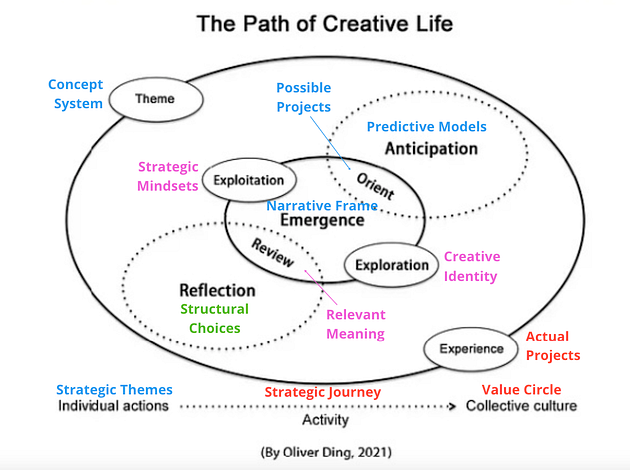
Some related frameworks can also be applied in three modes. For instance, the Thematic Identity Curation framework (see diagram) highlights the following key moments:
- Thematic Echo
- Thematic Blend
- Thematic Integration
- Creative Projects
- Identity Development
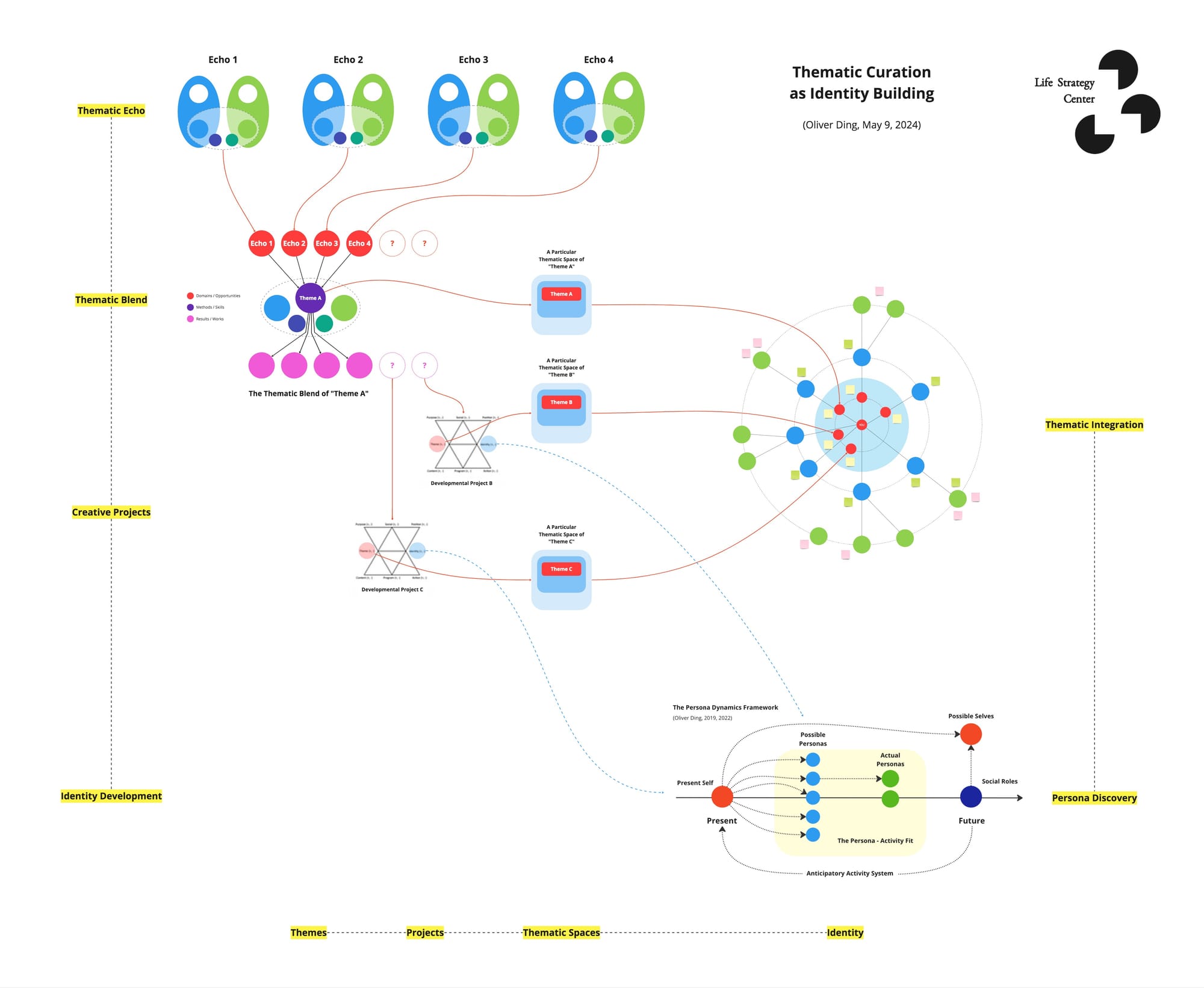
This framework allows for the design of three specific tasks:
- Past: Reflecting on the Thematic Echo
- Present: Running the Thematic Blend
- Future: Planning the Creative Project
Essentially, the Mapping Strategic Moves journey is not a linear path but a dynamic loop that encourages both reflection and forward movement. It invites creators to continuously explore, experiment, and transform. By applying this journey to our own projects, we can embrace the fluid nature of creation and the iterative cycles of knowledge and action.
The process itself becomes the product — a living testament to the ongoing journey of discovery, driving Creative Life forward!
7. Cultural Projection and Career Curation
The Mapping Strategic Moves method serves as the core methodology of the Strategic Life Development framework.
This project reflects my growing interest in exploring cultural innovation, adult development, and knowledge engagement. While the Creative Life Theory project primarily focused on knowledge engagement, the Strategic Life project shifted towards cultural innovation.
A month ago, I began writing a series of articles on the Mapping Strategic Moves method, using the House of Project Engagement to analyze several case studies from my creative journey between 2019 and 2024.
The result is a draft for a book titled Strategic Moves: Mapping Knowledge Engagement and Structural Choice (book, v1, 2024).
An unexpected by-product of this project is an emerging theme:
“Strategic Life”
Earlier today, I created a “Thematic Scrapboard” to explore this new theme — see the diagram below.
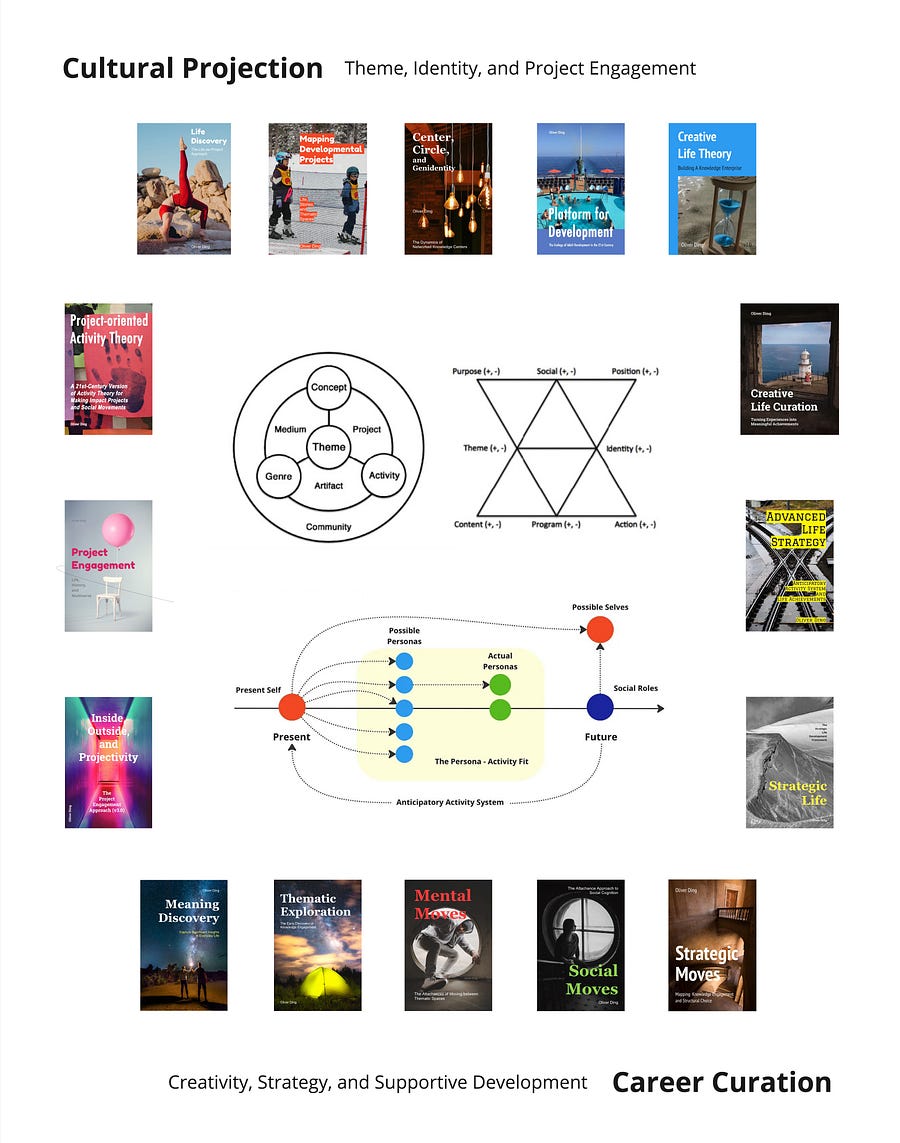
I revisited 16 book drafts I had written over the years and highlighted three models. This process revealed two key lines of thought:
- Cultural Projection: Theme, Identity, and Project Engagement
- Career Curation: Creativity, Strategy, and Supportive Development
It presents eight themes:
- Cultural Projection
- Theme
- Identity
- Project Engagement
- Creativity
- Strategy
- Supportive Development
- Career Curation
The theme of Cultural Projection draws inspiration from Activity Theory, particularly the Project Engagement Approach.
Meanwhile, Career Curation is informed by the Creative Life Curation framework, a sub-framework within both Creative Life Theory and Curativity Theory.
The Mapping Strategic Moves method and the Strategic Life Development framework are deeply rooted in these theoretical foundations. Together, the themes of Cultural Projection and Career Curation reflect the ongoing tension between social structure and individual agency — a classic debate in social science.
This thematic network has the potential to evolve into a new concept system!
v1 - October 29, 2025 - 4,167 words
